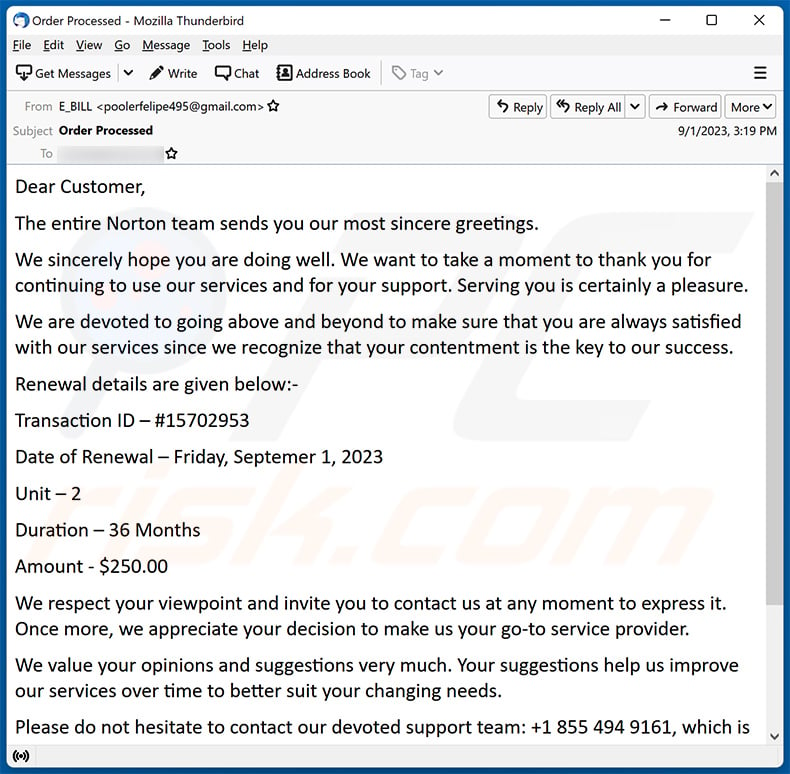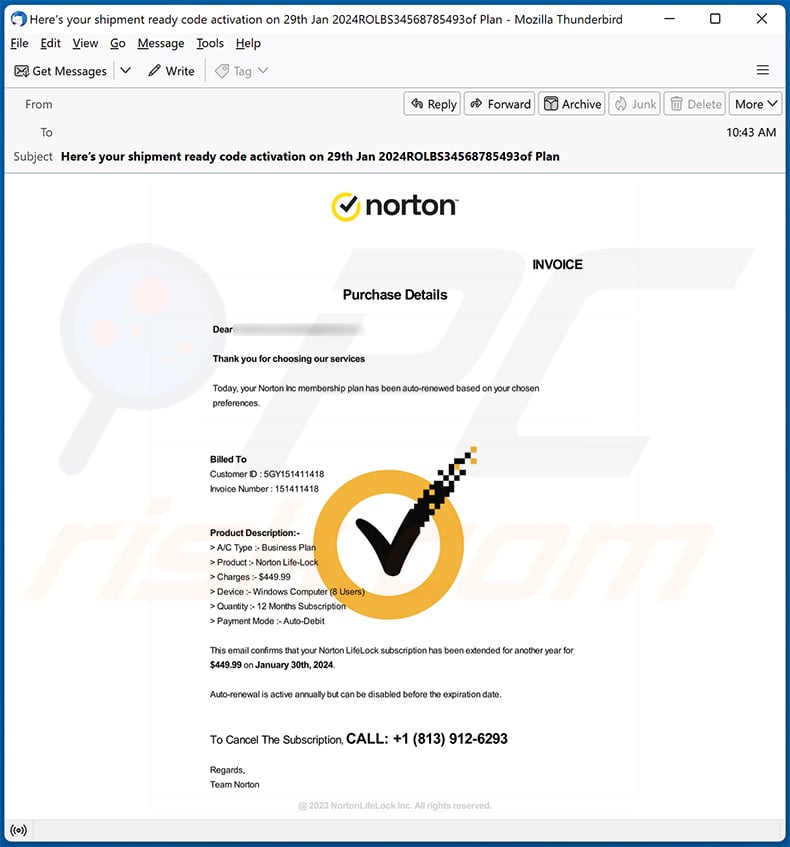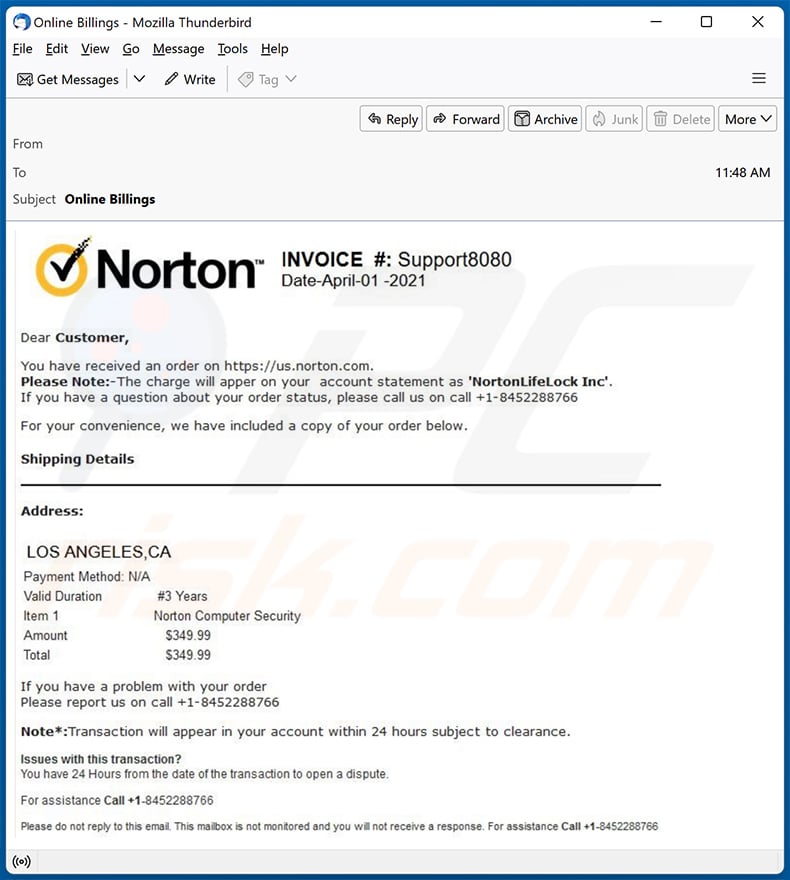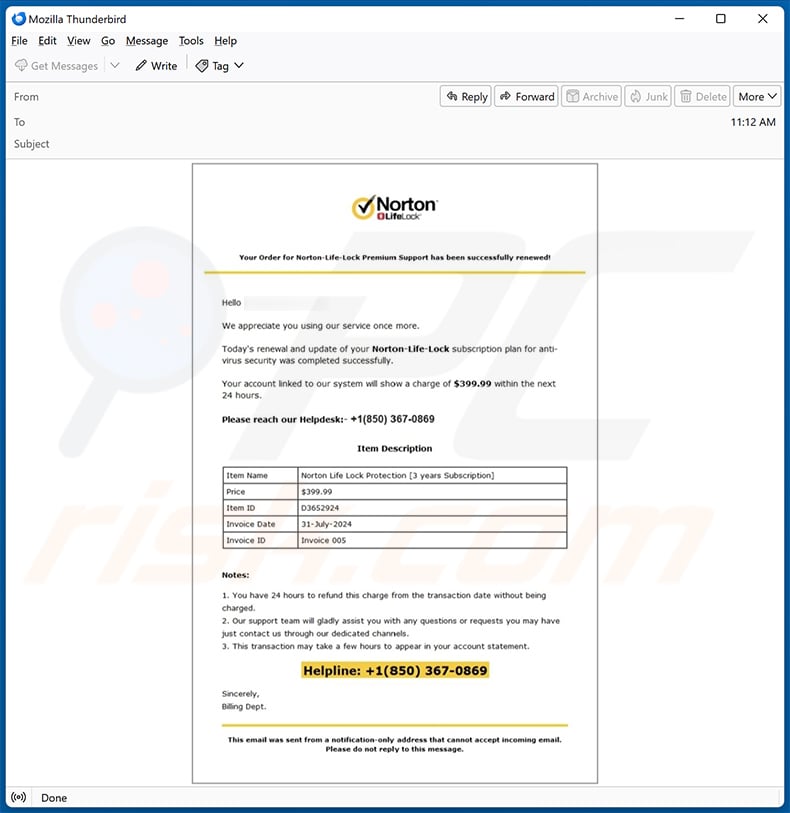Avoid getting scammed by fake "Norton Subscription Renewal Confirmation" email
Phishing/ScamAlso Known As: "Norton Subscription Renewal Confirmation" spam email
Get free scan and check if your device is infected.
Remove it nowTo use full-featured product, you have to purchase a license for Combo Cleaner. Seven days free trial available. Combo Cleaner is owned and operated by RCS LT, the parent company of PCRisk.com.
What kind of email is "Norton Subscription Renewal Confirmation"?
Our examination of the "Norton Subscription Renewal Confirmation" email revealed that it is spam. This scam letter proclaims that the recipient's protection subscription has been renewed for another year. The goal is to trick recipients into calling the fake helpline and entangling them in a scam.
It must be stressed that the information provided by this email is false, and this mail is in no way associated with the Norton AntiVirus.

"Norton Subscription Renewal Confirmation" email scam overview
The email with the subject "Renewal Confirmation08-24-2023" (may vary) is presented as a notification from Norton. It informs the recipient that their anti-virus subscription has been automatically renewed for one year. The price is 189.90 USD, and a 10% discount is available for a limited time. The letter instructs to call support if the recipient has "questions, worries, or ideas".
It must be mentioned that all these claims are false, and this email is not associated with Norton AntiVirus or its developer Gen Digital.
Callback scams like "Norton Subscription Renewal Confirmation" can operate in various ways. These schemes can take place entirely over the phone.
Scammers, while pretending to be support, can trick victims into disclosing private data (e.g., personally identifiable details, log-in credentials, credit card numbers, etc.) on call or by entering it into phishing websites/files. Cyber criminals may also deceive users into downloading/installing trojans, ransomware, cryptominers, or other malware.
Spam mail of this kind often promotes refund scams, which share traits with technical support scams. These schemes entail scammers requesting remote access to the victims' devices. Typically, software like TeamViewer, UltraViewer, AnyDesk, or other remote access programs are used.
The fake support then claims to aid users with the subscription cancellation or refund process. In the latter, the victims are asked to sign into their online banking accounts. The screen is darkened (using a feature of the remote access software), and the user is asked to enter the refund amount. Meanwhile, the criminals either move funds (e.g., from savings to checking) or edit the webpage's HTML to create the impression that the victim made an error.
Supposedly, a significantly larger sum was transferred to the account, but in fact no money was received. The scammers then request, beg, or demand that the nonexistent excess be returned.
Difficult-to-trace methods are preferred to transfer funds, e.g., cryptocurrencies, pre-paid vouchers, gift cards, or cash hidden in innocent-looking packages and shipped. These methods are chosen so as to minimize the chances of persecution and fund retrieval.
It is noteworthy that cyber criminals can cause other damage when connected to devices, e.g., disable/uninstall security tools, install fake anti-viruses, extract sensitive data, or infect the system with malware.
In summary, victims of scams like "Norton Subscription Renewal Confirmation" may experience system infections, severe privacy issues, significant financial losses, and identity theft.
If you have allowed scammers to access your device remotely – immediately disconnect it from the Internet. Afterward, remove the remote access software that the criminals used since they may not need your permission to reconnect. Lastly, perform a full system scan with an anti-virus and eliminate all threats.
If you've provided your log-in credentials to scammers – change the passwords of all potentially compromised accounts and inform their official support. And if you believe that your other private information has been exposed (e.g., ID card details, passport photos/scans, credit card numbers, etc.) – contact the appropriate authorities without delay.
| Name | "Norton Subscription Renewal Confirmation" spam email |
| Threat Type | Phishing, Scam, Social Engineering, Fraud |
| Fake Claim | Recipient's Norton subscription has been renewed for another year. |
| Disguise | Norton AntiVirus |
| Support Scammer Phone Number | +1 (866) 352-1613, (818) 273-1583, +1 (813) 912-6293, +1(844) 567-0224, +1-(888) 537-1365 |
| Symptoms | Unauthorized online purchases, changed online account passwords, identity theft, illegal access of the computer. |
| Distribution methods | Deceptive emails, rogue online pop-up ads, search engine poisoning techniques, misspelled domains. |
| Damage | Loss of sensitive private information, monetary loss, identity theft. |
| Malware Removal (Windows) |
To eliminate possible malware infections, scan your computer with legitimate antivirus software. Our security researchers recommend using Combo Cleaner. Download Combo CleanerTo use full-featured product, you have to purchase a license for Combo Cleaner. 7 days free trial available. Combo Cleaner is owned and operated by RCS LT, the parent company of PCRisk.com. |
Similar spam campaign examples
"Walmart Order", "PayPal - Order Has Been Completed", and "Thank You For Shopping With Apple" are a few examples of emails promoting refund scams that we have analyzed recently.
Spam mail is used to facilitate various scams, e.g., phishing, sextortion, tech support, inheritance, lottery, etc. What is more, these letters are used to proliferate malware.
Due to how widespread spam mail is and how well-crafted it can be – we strongly advise exercising caution with incoming emails, PMs/DMs, SMSes, and other messages.
How do spam campaigns infect computers?
Spam campaigns are commonly used in malware distribution. These emails/messages can promote malicious files in the form of attachments or download links. Virulent files can be documents (PDF, Microsoft Office, Microsoft OneNote, etc.), executables (.exe, .run, etc.), archives (RAR, ZIP, etc.), JavaScript, and so forth.
Such a file initiates malware download/installation processes once opened. However, some formats may need additional user interaction to jumpstart infection chains. For example, Microsoft Office documents require users to enable macro commands (i.e., editing/content), while OneNote files need them to click embedded files or links.
How to avoid installation of malware?
It is paramount to be careful with incoming emails and other messages. We advise against opening attachments or links found in suspicious mail, as they can be malicious. We recommend using Microsoft Office versions released after 2010 since they have the "Protected View" mode that prevents automatic macro command execution.
It must be mentioned that malware is not spread exclusively through spam mail. Hence, we advise being vigilant when browsing since fake and dangerous online content usually appears genuine and harmless.
Additionally, all downloads must be performed from official and verified channels. Another recommendation is to activate and update software using legitimate functions/tools, as illegal activation tools ("cracks") and third-party updaters can contain malware.
We must emphasize the importance of having a dependable anti-virus installed and kept updated. Security programs must be used to run regular system scans and to remove threats/issues. If you've already opened malicious attachments, we recommend running a scan with Combo Cleaner Antivirus for Windows to automatically eliminate infiltrated malware.
Text presented in the "Norton Subscription Renewal Confirmation" spam email letter:
Subject: Renewal Confirmation08-24-2023
Greetings of the Day!
Dear Customer,
This email serves as a confirmation that you renewed your one-year Norton protection subscription for $189.90 on August 24, 2023.
You have a 10% discount off the standard price and your auto renewal has been activated. Only until August 24th, 2023, is this offer good. Act now to save!
Renewal date: Thursday, August 24, 2023
Invoice Number: 49701539
License key: P2X5-R8N1-L3V8-D5G1
Term plan: 12 Months
Amount: $189.90
We constantly strive for quality in all facets of our organization in order to not just meet but also surpass your expectations. We also recognize that your tastes and needs may change over time.
Call us at +1 (866) 352-1613 for a rapid response if you have any questions, worries, or ideas.
Thank you,
Team Norton
Another example of an email from "Norton Subscription Renewal Confirmation" spam campaign:

Text presented within:
Subject: Order Processed
Dear Customer,
The entire Norton team sends you our most sincere greetings.
We sincerely hope you are doing well. We want to take a moment to thank you for continuing to use our services and for your support. Serving you is certainly a pleasure.
We are devoted to going above and beyond to make sure that you are always satisfied with our services since we recognize that your contentment is the key to our success.
Renewal details are given below:-
Transaction ID – #15702953
Date of Renewal – Friday, Septemer 1, 2023
Unit – 2
Duration – 36 Months
Amount - $250.00
We respect your viewpoint and invite you to contact us at any moment to express it. Once more, we appreciate your decision to make us your go-to service provider.
We value your opinions and suggestions very much. Your suggestions help us improve our services over time to better suit your changing needs.
Please do not hesitate to contact our devoted support team: +1 855 494 9161, which is available around-the-clock, if you have any queries or need more help.
Best wishes,
Team Norton
Another example of an email from "Norton Subscription Renewal Confirmation" spam campaign:

Text presented within:
Subject: Here’s your shipment ready code activation on 29th Jan 2024ROLBS34568785493of Plan
NORTON
INVOICE
Purchase DetailsDear -
Thank you for choosing our services
Today, your Norton Inc membership plan has been auto-renewed based on your chosen preferences
Billed To
Cusotmer ID : 5GY151411418
Invoice Number : 151411418Product Description:-
> A/C Type :- Business Plan
> Product :- Norton Life-Lock
> Charges :- $449.99
> Device :- Windows Computer (8 Users)
> Quantity :- 12 Months Subscription
> Payment Mode :- Auto-DebitThis email confirms that your Norton LifeLock subscription has been extended for another year for $449.99 on January 30th, 2024.
Auto-renewal is active annually but can be disabled before the expiration date.
TO Cancel The Subscription, CALL: +1 (813) 912-6293
Regards,
Team Norton© 2023 NortonLifeLock Inc. All rights reserved.
Another example of an email from "Norton Subscription Renewal Confirmation" spam campaign:

Text presented within:
Subject: Online Billings
Norton
INVOICE #: Support8080
Date-April-01 -2021Dear Customer,
You have received an order hxxps://us.norton.com.
Please Note:-The charge will apper on your acount statement as 'NortonLifeLock Inc'.
If you have a question about your order status, please call us on call +1-8452288766For your convenience, we have included a copy of your order below.
Shipping Details
Address:
LOS ANGELES,CA
Payment Method: N/A
Valid Duration #3 Years
Item 1 Norton Computer Security
Amount $349.99
Total $349.99If you have a problem with your order
Please report us on call +1-8452288766Note*:Transaction will appear if your account within 24 hours subject to clearance.
Issues with this transaction?
You have 24 Hours from the date of the transactions to open a dispute.
For assistance Call +1-8452288766
Please do not reply to this email. This mailbox is not monitored and you will not receive a response. For assistance Call +1-8452288766
Yet another example of an email from "Norton Subscription Renewal Confirmation" spam campaign:

Text presented within:
Norton LifeLock
Your Order for Norton-Life-Lock Premium Support has been successfully renewed!
Hello -
We appreciate you using our service once more.
Today's renewal and update of your Norton-Life-Lock subscription plan for anti-virus security was completed successfully.
Your account linked to our system will show a charge of $399.99 within the next 24 hours.
Please reach our Helpdesk:- +1(850) 367-0869
Item Description
Item Name | Norton Life Lock Protection [3 years Subscription]
Price | $399.99
Item ID | D3652924
Invoice Date | 31-July-2024
Invoice ID | Invoice 005Notes:
1. You have 24 hours to refund this charge from the transaction date without being charged.
2. Our support team will gladly assist you with any questions or requests you may have just contact us through our dedicated channels.
3. This transaction may take a few hours to appear in your account statement.Helpline: +1(850) 367-0869
Sincerely,
Billing Dept.
Update February 6, 2024 – a scammer linked to the "Norton Subscription Renewal Confirmation" spam campaign is facing wire fraud and other finance-related charges. More information on the scam's operation, as revealed by public court documents, can be found in an article by Bill Toulas on the Bleeping Computer website.
Instant automatic malware removal:
Manual threat removal might be a lengthy and complicated process that requires advanced IT skills. Combo Cleaner is a professional automatic malware removal tool that is recommended to get rid of malware. Download it by clicking the button below:
DOWNLOAD Combo CleanerBy downloading any software listed on this website you agree to our Privacy Policy and Terms of Use. To use full-featured product, you have to purchase a license for Combo Cleaner. 7 days free trial available. Combo Cleaner is owned and operated by RCS LT, the parent company of PCRisk.com.
Quick menu:
- What is "Norton Subscription Renewal Confirmation" spam email?
- Types of malicious emails.
- How to spot a malicious email?
- What to do if you fell for an email scam?
Types of malicious emails:
![]() Phishing Emails
Phishing Emails
Most commonly, cybercriminals use deceptive emails to trick Internet users into giving away their sensitive private information, for example, login information for various online services, email accounts, or online banking information.
Such attacks are called phishing. In a phishing attack, cybercriminals usually send an email message with some popular service logo (for example, Microsoft, DHL, Amazon, Netflix), create urgency (wrong shipping address, expired password, etc.), and place a link which they hope their potential victims will click on.
After clicking the link presented in such email message, victims are redirected to a fake website that looks identical or extremely similar to the original one. Victims are then asked to enter their password, credit card details, or some other information that gets stolen by cybercriminals.
![]() Emails with Malicious Attachments
Emails with Malicious Attachments
Another popular attack vector is email spam with malicious attachments that infect users' computers with malware. Malicious attachments usually carry trojans that are capable of stealing passwords, banking information, and other sensitive information.
In such attacks, cybercriminals' main goal is to trick their potential victims into opening an infected email attachment. To achieve this goal, email messages usually talk about recently received invoices, faxes, or voice messages.
If a potential victim falls for the lure and opens the attachment, their computers get infected, and cybercriminals can collect a lot of sensitive information.
While it's a more complicated method to steal personal information (spam filters and antivirus programs usually detect such attempts), if successful, cybercriminals can get a much wider array of data and can collect information for a long period of time.
![]() Sextortion Emails
Sextortion Emails
This is a type of phishing. In this case, users receive an email claiming that a cybercriminal could access the webcam of the potential victim and has a video recording of one's masturbation.
To get rid of the video, victims are asked to pay a ransom (usually using Bitcoin or another cryptocurrency). Nevertheless, all of these claims are false - users who receive such emails should ignore and delete them.
How to spot a malicious email?
While cyber criminals try to make their lure emails look trustworthy, here are some things that you should look for when trying to spot a phishing email:
- Check the sender's ("from") email address: Hover your mouse over the "from" address and check if it's legitimate. For example, if you received an email from Microsoft, be sure to check if the email address is @microsoft.com and not something suspicious like @m1crosoft.com, @microsfot.com, @account-security-noreply.com, etc.
- Check for generic greetings: If the greeting in the email is "Dear user", "Dear @youremail.com", "Dear valued customer", this should raise suspiciousness. Most commonly, companies call you by your name. Lack of this information could signal a phishing attempt.
- Check the links in the email: Hover your mouse over the link presented in the email, if the link that appears seems suspicious, don't click it. For example, if you received an email from Microsoft and the link in the email shows that it will go to firebasestorage.googleapis.com/v0... you shouldn't trust it. It's best not to click any links in the emails but to visit the company website that sent you the email in the first place.
- Don't blindly trust email attachments: Most commonly, legitimate companies will ask you to log in to their website and to view any documents there; if you received an email with an attachment, it's a good idea to scan it with an antivirus application. Infected email attachments are a common attack vector used by cybercriminals.
To minimise the risk of opening phishing and malicious emails we recommend using Combo Cleaner Antivirus for Windows.
Example of a spam email:

What to do if you fell for an email scam?
- If you clicked on a link in a phishing email and entered your password - be sure to change your password as soon as possible. Usually, cybercriminals collect stolen credentials and then sell them to other groups that use them for malicious purposes. If you change your password in a timely manner, there's a chance that criminals won't have enough time to do any damage.
- If you entered your credit card information - contact your bank as soon as possible and explain the situation. There's a good chance that you will need to cancel your compromised credit card and get a new one.
- If you see any signs of identity theft - you should immediately contact the Federal Trade Commission. This institution will collect information about your situation and create a personal recovery plan.
- If you opened a malicious attachment - your computer is probably infected, you should scan it with a reputable antivirus application. For this purpose, we recommend using Combo Cleaner Antivirus for Windows.
- Help other Internet users - report phishing emails to Anti-Phishing Working Group, FBI’s Internet Crime Complaint Center, National Fraud Information Center and U.S. Department of Justice.
Frequently Asked Questions (FAQ)
Why did I receive this email?
Spam mail is not personal. These emails are distributed in large-scale operations – therefore, thousands of users receive identical messages.
I have provided my personal information when tricked by this spam email, what should I do?
If you have disclosed your account credentials – change the passwords of all possibly compromised accounts and inform their official support without delay. And if you've provided other private information (e.g., ID card details, passport scans/photos, credit card numbers, etc.) – immediately contact the corresponding authorities.
I have allowed cyber criminals to remotely access my computer, what should I do?
If you have permitted cyber criminals to access your computer remotely – disconnect it from the Internet. The remote access program (e.g., TeamViewer, UltraViewer, etc.) used by the criminals must be removed, as they may reconnect without your consent. Afterward, run a complete system scan and remove all detected threats.
I have read a spam email but didn't open the attachment, is my computer infected?
Devices are infected when malicious attachments or links are opened; merely reading an email will not trigger any malware download/installation processes.
I have downloaded and opened a file attached to a spam email, is my computer infected?
Whether an infection occurred might depend on the opened file's format. If it was an executable (.exe, .run, etc.) – most likely, yes. However, you may have avoided this if it was a document (.doc, .xls, .pdf, .one, etc.). These formats might need additional actions (e.g., enabling macro commands, clicking embedded files/links, etc.) to trigger malware download/installation chains.
Will Combo Cleaner remove malware infections present in email attachments?
Yes, Combo Cleaner is designed to detect and eliminate threats. It is capable of removing most of the known malware infections. Keep in mind that performing a complete system scan is key – since sophisticated malicious software usually hides deep within systems.
Share:

Tomas Meskauskas
Expert security researcher, professional malware analyst
I am passionate about computer security and technology. I have an experience of over 10 years working in various companies related to computer technical issue solving and Internet security. I have been working as an author and editor for pcrisk.com since 2010. Follow me on Twitter and LinkedIn to stay informed about the latest online security threats.
PCrisk security portal is brought by a company RCS LT.
Joined forces of security researchers help educate computer users about the latest online security threats. More information about the company RCS LT.
Our malware removal guides are free. However, if you want to support us you can send us a donation.
DonatePCrisk security portal is brought by a company RCS LT.
Joined forces of security researchers help educate computer users about the latest online security threats. More information about the company RCS LT.
Our malware removal guides are free. However, if you want to support us you can send us a donation.
Donate
▼ Show Discussion